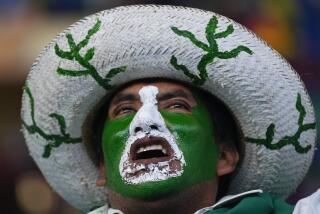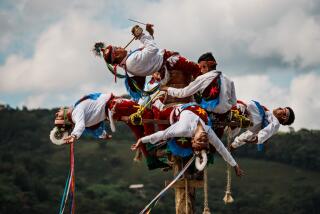Bolivia’s Andean festival clouded by economic, political crises this year

- Share via
LA PAZ, Bolivia — Bolivia’s largest Andean religious festival has long inspired joyous revelry and offered a chance for the nation to forget about its perpetual political turmoil and escape into the world of its rich folklore.
But this year, Bolivians say the festival of the Gran Poder, or Great Power — the beloved carnival dedicated to a 17th century painting of Jesus Christ — reflects more than distracts from the country’s spiraling economic and political crises.
The typically exuberant crowd fell silent for a few moments Saturday before the folk dance performance kicked off in the major city of La Paz, paying respects to the victims of clashes between protesters and police days earlier that left two civilians and four police officers dead.
One of the civilians, identified by protesters as a young student beaten by police, had been hospitalized and succumbed to his injuries Saturday, just before the festival.
After Bolivia’s electoral tribunal disqualified former President Evo Morales, a leftist political titan who still wields influence in the country’s tropical heartland, from running in the August presidential election, his loyalists took to the streets this month to vent their outrage.
Many of them have reported being bruised and beaten by officers in recent days in protests both peaceful and violent. The government sent military tanks to the streets of Llallagua, in central Bolivia.
La Paz municipal authorities proposed postponing the festival, citing the “pain of the Bolivian people.” But organizers refused, pointing to the $68 million that was expected to be generated Saturday — a shot of stimulus into a sputtering economy witnessing its worst crisis in 40 years.
The annual festival, which takes place about eight weeks after Easter, was recognized by the UNESCO World Heritage Committee for displaying the nation’s unique mix of Roman Catholic beliefs and Indigenous heritage.
The ceremony pays tribute to what is believed to be a miraculous rendering of Jesus Christ — El Señor del Gran Poder, or the Lord of the Great Power — that shows the Christian savior with Indigenous Andean features and outstretched arms.
Dancing in the festival is a holy act of spiritual devotion as dancers pray for personal forgiveness and salvation. This year, however, many turned their prayers on a more immediate target.
“Devotees are asking for economic recovery, as well as for peace and unity among Bolivians in this time,” said a priest leading the ceremony, Father Saul Mamani.
Economic strain was visible at Saturday’s giant party: Participants pared down their usually elaborate costumes and masks, and dancers traded their traditional gold jewelry for Chinese-made knockoffs.
“The price of my costume went up by 60%,” said dancer Jorge Rodríguez, 37. “Many haven’t been able to dance. Almost half of my group didn’t come.”
Organizers could afford to hire only about 70,000 dancers — some 20,000 fewer than last year — and scrapped their usual plans to invite regionally renowned musicians.
Every year, one of La Paz’s wealthy merchants, known as qamiris, gets the expensive honor of paying more than anyone else for Gran Poder. This year, the unlucky merchant, Edgar Apaza, said he had been saving all year and his budget was still tighter than ever before.
“The crisis is affecting everyone,” Apaza said.
Inflation in Bolivia over the first five months of 2025 hit 9.81%, the highest rate in more than a decade, according to official figures, fueling public protests over President Luis Arce’s handling of the economy and leaving many Bolivians struggling to buy even the basics.
Plácida Quispe, 73, an embroiderer at the festival Saturday, said there wasn’t enough demand to sell her colorful costumes this year. She said she would rent her handiwork to participants instead.
“There is no business,” she said. “People want to celebrate, but they cannot afford to pay the price.”
Flores writes for the Associated Press.
More to Read
Sign up for Essential California
The most important California stories and recommendations in your inbox every morning.
You may occasionally receive promotional content from the Los Angeles Times.













